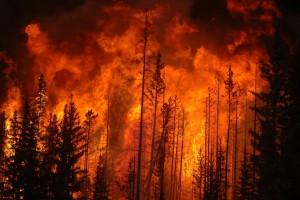Wildfires are tearing across Alaska and western Canada at a record-breaking rate this summer. Stands of blackened trees and cross-continental plumes of smoke are only the most visible signs of damage from the 300 or more fires currently raging. The smoke has been evident in the American Midwest for some days now. The biggest concern, however, may be what’s happening below ground.
 Globally, soils contain more carbon than above ground vegetation and the atmosphere combined. In warmer parts of the world, soil microorganisms chew through dead plants and animals very quickly, cycling their organic carbon back to the atmosphere as CO2. But in the boreal forests, peatlands and tundra that stretch across our planet’s high latitudes, long winters and short growing seasons slow microbial decomposition, allowing carbon-rich organic matter to accumulate. That’s why, even though boreal forests cover a slightly smaller area than tropical forests, they sequester nearly three times as much carbon in their soils. Canada’s boreal forests cover nearly 60% of the nation’s land area.
Globally, soils contain more carbon than above ground vegetation and the atmosphere combined. In warmer parts of the world, soil microorganisms chew through dead plants and animals very quickly, cycling their organic carbon back to the atmosphere as CO2. But in the boreal forests, peatlands and tundra that stretch across our planet’s high latitudes, long winters and short growing seasons slow microbial decomposition, allowing carbon-rich organic matter to accumulate. That’s why, even though boreal forests cover a slightly smaller area than tropical forests, they sequester nearly three times as much carbon in their soils. Canada’s boreal forests cover nearly 60% of the nation’s land area.
Much of that centuries-old carbon is now going up in smoke, in what could represent a major new source of heat-trapping CO2 to our planet’s atmosphere. Climate Central, a nonprofit news organization that analyzes and reports on climate science, says the prevailing dogma used to be that carbon-rich peatlands simply didn’t burn. Shifting weather patterns and unprecedented drought are quickly changing that:
As warming dries out forests and precipitation patterns change, the water table is dropping in once swampy areas. That makes peat susceptible to burning and when it does catch fire, centuries’ worth of carbon can burn up in the span of a few hours if fires are intense enough. Peat fires are also notoriously resilient, smoldering for days, weeks or even popping up again after a winter of smoldering beneath the surface.
Measuring soil carbon stocks and fluxes is a labor-intensive business. It will be some time before scientists have good idea just how much carbon this summer’s fires blew skyward. But with bad wildfire seasons like this one becoming the new normal, and soil carbon stocks taking decades to centuries to rebuild, the outlook for one of our planet’s most important natural carbon sinks is looking pretty grim.